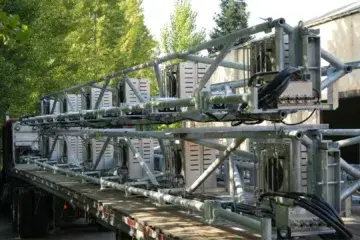The BioAcoustic Fish Fence (BAFF) at Barkley Lock, Kentucky has been in operation for over two years and has shown promising results in deterring the upstream migration of invasive carp. Over this time the Research Group assessing the BAFF at Barkley Lock has gained a greater understanding about the movement of carp around Barkley Lock, and with two years of data on a standard configuration it has now been agreed that FGS may work on optimising the system to maximise the performance of the system.
The initial optimisation was implemented at the end of April, to coincide with the Research Group’s spring tagging event, and the changes will be assessed by the Research Group over the summer, with results being available early 2024.
Optimisations
When considering optimisation one of the most important factors in the success of the BAFF is the soundscape that it produces. There are a number of ways that BAFF systems and the soundscape can be optimised and these include-
- Focusing the signal to concentrate on key fish species
- Increasing the acoustic output of the system
- Adjusting the bubble curtain / air flow
- Introducing CO2 into the bubble curtain
- Making real-time system adjustments, associated with event-based operations, such as lockages
The signal at Barkley is already focused on deterring Invasive Carp and while event-based operation is possible, we need to wait for further TTE (Time-to-Event) analysis to be completed by the Research Group before implementing these changes to the operation of the system.
One option considered for Barkley was the bubble curtain. The specification for a bubble curtain is generated during the design phase of the project, and in this instance there was an allowance in capacity of the compressor to run additional bubble lines to increase the density of the bubble curtain if required. There are acoustic ramifications to changing the bubble curtain, however this can help to improve bubble curtain uniformity, particularly during high water levels.
The optimisation selected for evaluation over the forthcoming summer has focused on increasing the acoustic output of the system, which has been boosted to increase the overall sound pressure levels in the BAFF.
With further work it is hoped to be able to introduce other improvements, such as the introduction of CO2.
The Big Picture
The BAFF is a valuable tool in the fight against invasive carp. However, it is important to remember that the BAFF is one part of what needs to be a comprehensive, cohesive strategy to prevent the spread of invasive carp. By optimising the BAFF and increasing its implementation, we can further reduce the risk of invasive carp entering Lake Barkley and other waterways.
In addition to the above, there are a number of other factors that can be considered when optimising the BAFF at Barkley Lock, and BAFFs as a wider tool for managing Invasive Carp. These include:
- The removal of carp that have been deterred by the BAFF by using the BAFF to guide fish towards a trapping system so they can be harvested and removed from the waterway.
- The development of a public education campaign to raise awareness of the BAFF and its importance in preventing the spread of invasive carp.
By taking these steps, we can make the BAFF at Barkley Lock even more effective in protecting our waterways from invasive carp.


